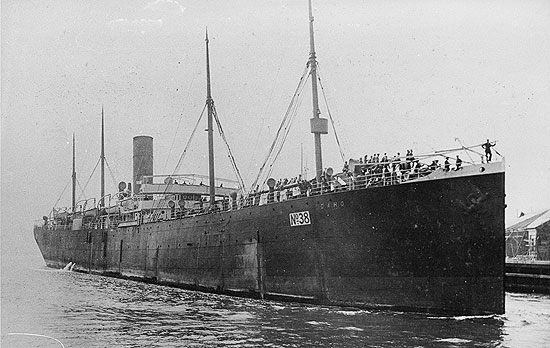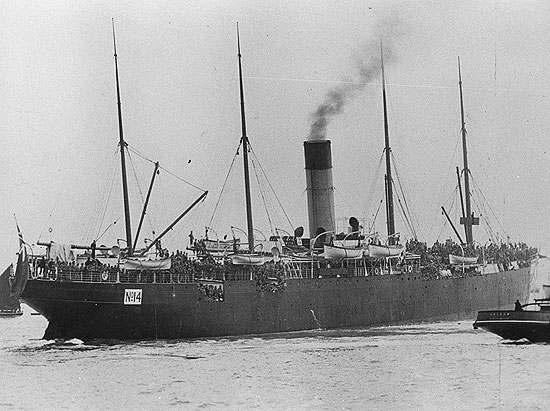Troopships and the Regiment
The Boer War Period
Before recording some of the voyages to South Africa by ship conveying our Regiments (and drafts) to the war zone it is worth mentioning some of the statistics concerning the war. In particular, the passage of troops, stores and horses, shows what a logistical nightmare it must have been.
The following statistics are of interest:
The cost to the nation in money was £223 million which, as the war lasted over thirty-one months gives an average cost of over £7 million a month, or £240,000 a day, or £10,000 per hour. Number of officers and men employed in the War from first to last is officially given as 448,435, of whom 12,546 were in South Africa when military operations began. Killed in Action. The total number of officers and men killed in action was 5,774, and wounded, 22,829. This works out to almost four wounded for every man killed in the field in action. The total losses suffered in the struggle by the British were given in an official return: Deaths in South Africa, 21,942; missing, 104; invalided home and died, 568; invalids on longer of use, 5,879. Total, 28,434. Loss of Horses and Mules. Between November, 1899, and June 1900, when Lord Roberts entered Pretoria, the official figures show that 104,000 horses, cobs, and mules were purchased or landed, and while during the period between 1899 and 1901 no less than 206,000 horses and 92,000 mules were shipped, apart from purchases in South Africa alone. Yet not withstanding these colossal shipments, the army was repeatedly in want of remounts, and had on occasions to suspend its operations because horses were not available.
Transportation of Troops. In October, 1899, from various ports in the United Kingdom were dispatched 28,763 officers and men; in November, 29,174; in December, 19,763; in January, 1900, 27,854; in February, 33,591; in March, 27,348. The grand total, 166,277, may thus be summarized: from October 20 to March 31 – 162 days – an average of over 1,000 men sailed daily from Great Britain or Ireland for the seat of war. As an illustration of the carrying capacity of our great ocean steamers, it may be of interest to state that the Cymric carried a brigade division of artillery, 18 gun, 36 waggons, 351 officers and men, together with 430 horses, with all the ammunition and impedimenta, and in addition there was on board a battalion of infantry on nearly 1,600 men. Another ship, the Kildonan Castle, carried an average of 2,700 officers and men on each of three voyages. The greatest number of men carried in any one trip was 2,893 by the Bavarian.
Close of the War. The total number of the British forces in the field at the cessation of hostilities, excluding local forces, was 202,000 men.
The 2nd Surreys were stationed in Dover in 1899 when orders came for them to move to South Africa. Under command of Lt Col R H W H Harris, the battalion embarked on the hired transport SS Ligmore Castle. The strength on embarkation was 26 officers, 1 warrant officer, 58 sergents, 53 corporals, 16 drummers and 1,038 private soldiers. The eigth company sailed on the SS Harlech Castle. Both vessels sailed on the 20th October 1899. The troops disembarked at Durban Harbour on the 14th November. On the 5th January 1903 2 Surreys embarked in Durban for Bombay, arriving there on the 9th January.
The 3rd Volunteer Battalion embarked at Southampton on the 13th February 1900 on the SS Cophalonia and arrived at South Arm, Cape Town on 27th March. Strength of the unit was 29 officers and 516 men. They left South Africa, Cape Town on the 9th March and berthed at Southampton on 1st April 1902. They travelled on the SS Canada.
HMT Idaho conveyed 23 officers and 617 other ranks for South Africa on 5th June 1901.

MT Idaho, 3 East Surrey Regiment in Southampton for South Africa 5th June 1901..
HMT Yorkshire carried 2 Queen's to Cape Town on 20th October 1895.
« Previous ![]() Back to List
Back to List ![]() Next »
Next »

HMT Yorkshire, 2 QRR to South Africa, 20th October 1899.
Related
